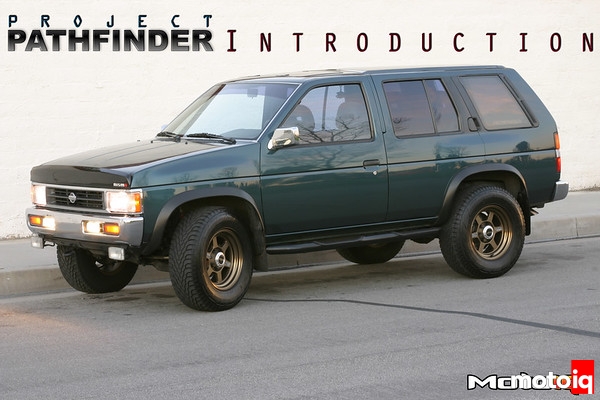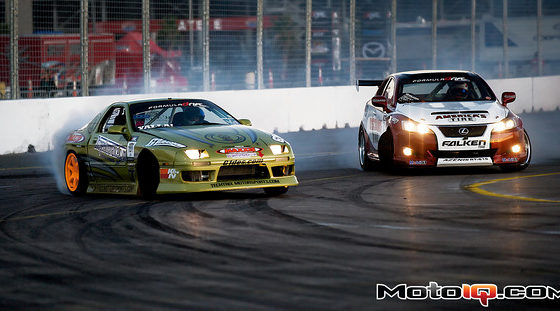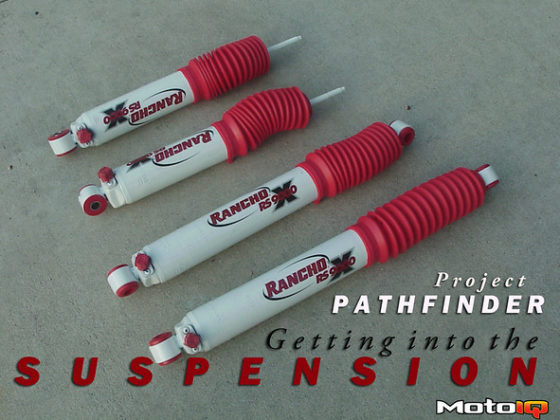
Project Pathfinder Part 1
Project Pathfinder started out as a necessity, not because we are into SUV’s or off road but because of a need. For the last two years we have been racing in NASA’s SE-R cup series and using our old 1993 Pathfinder SE as a two vehicle. This taught us a couple of things, 1 a stock old Pathfinder is not a good tow vehicle due to a lack of power and brakes and 2 a SUV is probably not the safest vehicle on the road for carrying your loved ones due to its tipsy handling.
Our Pathfinder is saddled with an old school VG30E engine pumping out a Pathetic 160 hp and a lame towing capacity of 3000 lbs. When towing our race car, we exceed this by quite a bit, which caused drama at every hill. When there are crosswinds the big trailer makes driving a case of the tail wagging the dog. To properly tow, we really should have a ½ ton pick up or a bigger V-8 domestic SUV. Since new SUV’s and trucks are expensive, we don’t want to deal with a domestic truck and quality issues, and the Pathfinder is long ago paid for, we will attempt to turn our Pathfinder into a decent towmobile. Our Pathfinder runs perfectly well and is in great shape despite 16 years of use and 120 k miles on the odometer, a testament to Nissans reliability. The engine is smooth and doesn’t burn a drop of oil. Our Pathfinder has not had one single repair done to it due to a breakdown, only routine maintenance. Despite its age, we think we can get old paint up to the task of racecar hauling.
Our first chapter of Project Pathfinder deals with getting some of the handling issues solved by aiding in the traction and braking department. We will also take some measures to assure transmission reliability. I have always hated the styling of the Stock Pathfinder SE’s alloy wheels, which are jokingly called moon buggy wheels by Pathfinder lovers. The styling is hideous, they are heavy at about 30 lbs each and they attract brake dust like you would not believe. Although they seem easy to clean, they have many nooks and crannies that need a detailer’s brush and elbow grease to get brake dust out of.
We dealt with this problem the easy way by selling the stock wheels as scrap, replacing them with some ultra trick Rays Volk TE37X wheels from Mackin Industries. We replaced the stock 15×7 inch wheels with some 16 x 8.5” TE37X’s with a zero offset. This gives us over 4” more inches track width making the Pathfinder much more tip resistant, important to us as it will help keep our family safe when we are not towing. Our Pathfinder is the SE 4WD model, which has large fender flairs stock, which accommodates our larger wheels without sticking out alike a Tonka toy. The 16” wheels allow us to use a lower profile less squirmy tire for better handling but the sidewall will still be tall enough to air down for off road action as we occasionally do some offroading in this car.
 |
| Ray Volk TE37X’s |
The TE37X features light forged construction instead of the common cast. Forging means that the wheel, like all TE37’s is smashed out of a billet of aluminum at high pressures. This refines the grain of the metal and increases its strength, ductility and toughness greatly. The added strength that forging imparts allow the engineers at Rays to greatly thin out the sections of the wheel without giving up strength. Even beefed up over a regular road racing TE37 to withstand off road abuse, the TE37X weighs in at a feathery 18 lbs, vs the nearly 30 lbs of the stock wheel!
Since we mostly drive the Pathfinder on road and long distances for towing, we chose a more street biased tire, one that gives ok grip off road but way better traction than typical off road tires on pavement. We chose the Yokohama AVS S/T in 265/70-16. This tire is way bigger than the stock sized tires which will give us better grip on road and better flotation off road. The AVS S/T is a truck tire with an aggressive unidirectional tread for excellent wet and dry traction, which still offers adequate traction on dirt. It is a fine choice for us as even though our project is 4WD, to be honest, we spend the vast majority of out time on pavement.
Even though our new tires are much bigger and wider, our lightweight wheels make up for it so we have surprisingly not sacrificed any of our much-needed acceleration! We were surprised at the greatly improved grip and stability these bigger wheels and tires provided. The added grip brought some issues to light however. The Pathfinder had a great deal of body roll and since the 120,000 mile stock suspension had sagged several inches, the big tires were rubbing in the wheel wells. In future editions of project pathfinder we will address these issues with some parts from Rancho, Energy suspension and Nissan Motorsports.
Next on the agenda was giving the brakes a hand. Trying to stop the 4000 lb Pathfinder and a 4000 lb trailer and racecar was an iffy proposition. Even though our Pathfinder was equipped with big 4 wheel disk brakes, we could not lock our big tires on clean dry pavement no matter how hard we pushed. In the short term we greatly helped out our brake system by installing a set of Axxis Metal Master metallic brake pads and replacing our stock brake fluid with Motul RBF 600.
 |
| Axxis Metal Master Metallic Brake Pads |
This improved our braking greatly to the point where we could lock the wheels if we tried and stopping with the trailer was perhaps improved 20 percent or more. So great is the improvement that any Pathfinder should run these pads. They also cost less than a set of stock genuine Nissan pads! We will be looking towards other brake upgrades in the near future so stay tuned.Next the stock transmission cooler is prone to clogging up with clutch fiber. This starves the rear planetary gears of oil resulting in a ruined transmission. It also transfers a lot of heat to the radiator coolant, which can contribute to overheating. We solved this problem by eliminating the stock transmission cooler replacing it with the stock transmission cooler from a 1995-present Pathfinder. This cooler is a bar and plate type much like a racing oil cooler. We mounted this cooler behind the grill to the radiator using a Hayes oil cooler mounting kit that we bought from Pep Boys. This cooler will assure us of reliability when towing.
We also replaced all of our lubricants with Motul Synthetics. Our oil was changed to 300V, our transfer case and differentials were treated to a dose of gear 300 and our transmission received some Motul synthetic ATF. As most people know, synthetics are superior to mineral lubricants under extreme temperatures and towing is perhaps the worst punishment you can apply to an underpowered truck.
Well that’s it for this installment, stay tuned, we will be working on our suspension and engine in the next installments of project Pathfinder.
Sources
Yokohama
Nissan Motorsports
Axxis
Motul




4 comments
I haven’t looked to see how old this post is. I’m an avid Pathfinder owner from a 92 to 95 period four wheel drive and two wheel drive. I have pulled hauled put 32 on and screamed as well as fought these trucks in every way. I also have driven countless years in miles without any problems and nothing but ready to go every day. I have 278000 miles on my 4 wheel drive right now. Other than a lifter tap in oil being leaked/or used I have nothing but a great truck. I found this story on the part where the motor was built. Incredibly surprised that the results you got from just driving was astounding to me. Now I’m going to read this all the way through and I thank you for doing this because I love this truck in every way except what it lacks in power and handling. It’s literally a perfect truck after you guys get done with it from what I can tell. As good as they can get and that’s making me want to know everything. thank you again.
Hi Terry, this was a very old project that has long since concluded but you can see the archives here. https://motoiq.com/category/projects/nissan/pathfinder/ We did a lot of things to the Pathfinder and it is still kicking in the good hands of the President of a Pathfinder club.
I’m also late to the party here, but I just picked up a 91 Pathfinder last night ($450… I couldn’t pass it up). It runs… Sort of.
I don’t intend to put a lot of money into it, mostly time and labor. I’ve read through all the posts, and I am curious to know how “worth it” all the engine work ended up being. I guess I’m still trying to get a sense for where to concentrate my time and money to get the most bang for my buck. Not looking to tow anything too heavy, or do any crazy off-road. I’d be curious to know your retrospective thoughts at this point. Thanks!
To me, it was worth it because stock, these engines are dogs, especially when compared to late model stuff.